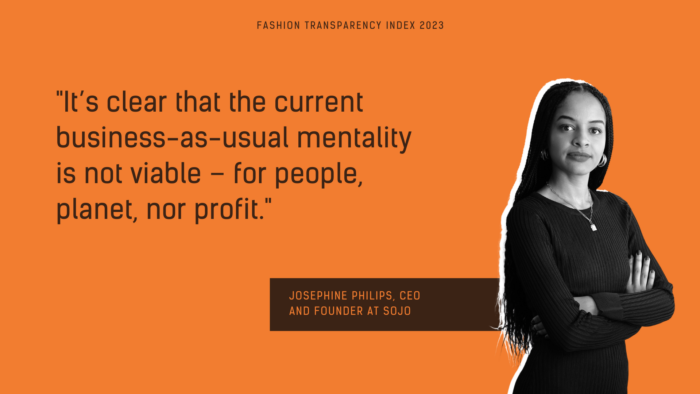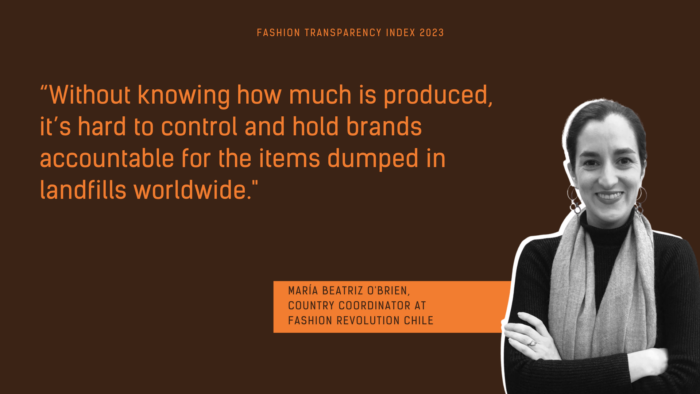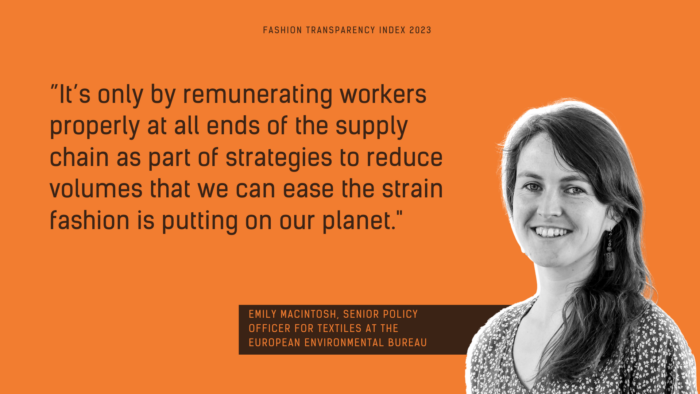Overcoming Overproduction: Experts unravel the challenge of circularity
Overproduction, overconsumption and waste continues to be a growing challenge. It’s one caused by the global fashion industry’s linear ‘take, make, dispose’ model where mostly non-recyclable materials are extracted, made into products, and ultimately down-cycled, sent to landfill, exported through the global secondhand clothing trade or incinerated when no longer used. A crucial way to tackle textile and clothing waste is by investing in efforts to slow down consumption and increase clothing longevity, which would have a significant positive impact on the environment.
A growing number of major brands explain how they’re developing circular solutions that enable textile-to-textile recycling – 38% of brands in 2023, up from 28% in 2022, indicating a big jump from the previous year. Yet, less brands (29%) disclose their annual fibre mix and only 4% of brands publish the percentage of their products designed to enable circularity – which allows for the raw materials in disused clothes to be transformed into raw materials for new clothes.
Given that historically, major brands have released so-called ‘sustainable’ lines representing just a fraction of overall production, the absence of disclosed data on the quantity of a brand’s products that are truly circular does not inspire confidence. In order for these circular solutions to meaningfully contribute to addressing fashion waste, they need to become the norm rather than the exception in the industry. As a first step, greater transparency on brands’ fibre mix is crucial to understanding how to unravel the challenge of circularity.
To better understand the challenges facing the fashion industry, we invited a range of industry stakeholders and activists to provide in-depth analysis of the issues surrounding circular solutions and how governments and brands can adapt their strategies to create meaningful change. Here, you can explore some viewpoints featured in the Fashion Transparency Index 2023.

BUSINESS AS USUAL IS NOT VIABLE
JOSEPHINE PHILIPS, Founder and CEO, SOJO
It’s great to see more of the major fashion brands offering repair services, 26% this year compared with 20% in 2022 – as it not only shows a growing desire from consumers to partake in these practices, but also that brands are taking more accountability for their items post the point of purchase, promoting more circular behaviours.
While this moves the industry in the right direction, it’s important to note that shifting towards circularity needs to happen at every stage of the lifecycle of a product – not just at the point of disposal. For example, when garments are designed with longevity and end-of-life in mind, it entails a different approach towards material sourcing, ways of manufacturing, and end-of-life recycling. Another critical aspect is changing the narrative of how and what we buy. Ultimately, by continuing to pump out the same product volumes, we are not addressing the root-causes of textile waste – overproduction and overconsumption.
Using technology to streamline the tailoring and repair process allows SOJO to provide these services in an easy and accessible way, with online orders and door-to-door delivery of newly fitted or fixed items. The hope is that in the long term this will trickle down to changing consumer behaviour – decreasing consumption volume by helping people love their items for longer.
The British Fashion Council reports an estimated annual cost to brands of £7 billion caused by returns processes with approximately 30% of items bought online returned. With sizing or fit attributed as a leading factor in a customer’s decision to return (93%) and responding to the limited, generic sizing offered by most brands, our services help customers tailor their clothing uniquely to their bodies. In this way, care and customisation of garments happens not only at end-of-life, but also holistically throughout the lifecycle of the garments, supporting the reduction of waste through minimising returns and reverse logistic implications.
These two areas of focus for SOJO show that growing a business is not incompatible with championing a circular fashion industry. In other words, being better for the planet and people does not mean bad business. It’s a very exciting time to be part of the industry, however, scale is critical for creating systemic change. This calls for brands and investors to place bets and take risks to help champion these solutions. Ultimately it’s in their incentive to be part of this change, since it’s clear that the current business-as-usual mentality is not viable – for people, planet, nor profit.

YOUR WASTE, OUR PROBLEM: GLOBAL LANDFILLS WITH LOCAL CONSEQUENCES
MARÍA BEATRIZ O’BRIEN, COUNTRY COORDINATOR, FASHION REVOLUTION CHILE
This viewpoint was featured in the 2022 edition of the Fashion Transparency Index, and so the data has been updated to reflect this year’s findings.
The Atacama Region offers a landscape of unique beauty in earthy and soft colours. The Altiplano Plateau near the Andes Mountains is home to an ancestral and rich textile culture of camelid wool and local iconography.
A world away, the global textile industry based on a fast fashion system continues to accelerate overproduction and overconsumption. Clothing is also massively under-utilised and socially devalued in a race for cheap garments and ever changing trends.
The 1980s marked a new economic model for Chile. Once a strong and proud manufacturing country, the eruption of free market policies made it impossible for the national textile industry to compete with low-cost imports. It encouraged the sale and import of second-hand clothing. Free trade agreements in the 1990s deepened and cemented the model.
The Atacama Desert is the second largest textile landfill in the world. Iquique is the capital of the region and a tax-free port, a point of entry for Chile and neighbouring countries, especially Bolivia. Most bales come in unsorted and the regional government has banned throwing textiles in the local trash. Every year, thousands of tonnes of imported clothes must end up somewhere.
Out of sight is out of mind. Rich countries can export their waste to low-income countries; wealthy neighbourhoods can do the same inside their own territories. Alto Hospicio is a poor community of land seizures and self-built houses. Around 50 landfills are dispersed throughout the area, with little chance of clothing recovery. Picture a scenery of silence; a place where time seems to stand still. Open land where people and nature fade away–a perfect spot to dump and forget.
According to the Fashion Transparency Index 2023, only 12% (30/250 brands) of brands surveyed disclose the quantity of products produced during the annual reporting period, a disappointing drop from last year; In 2022, the data corresponds to 15% (38/250 brands). Without knowing how much is produced, it’s hard to control and hold brands accountable for the items dumped in landfills worldwide.
In Alto Hospicio, clothes leak chemicals into the ground and synthetic microfibres scatter through the air and into the ocean. Water and air are highly polluted, especially because incineration is a common practice. The Index shows very small efforts being made in publishing annual progress on the reduction of synthetic materials deriving from fossil fuels. In 2023, 27% (67.5/250 brands) disclosed this information, up from 24% (59/250 brands) last year.
The Atacama Desert landfill shows the scale of the global waste problem of the fashion industry. For the region, this is an environmental and social disaster. Current national import legislation is lax and has made it impossible for the local industry to resuscitate, suffocated by thousands of tonnes of unwanted clothing from the rest of the world. The region has the right to determine its own textile sovereignty and develop a local economy based on ancestral knowledge and creative design practices, such as the local strong up-cycling movement and sustainable independent designers trying to shape a new national industry.
*Some information included in this viewpoint was provided by Desierto Vestido, a civil society organisation in Iquique raising awareness on the impact on the Atacama Landfill.

WE CANNOT RECYCLE OUR WAY OUT OF OVERPRODUCTION
EMILY MACINTOSH, Senior Policy Officer for Textiles, European Environmental Bureau
The European Parliament recently adopted the EU ‘Textile Strategy’ – a policy plan to bring down the environmental and social impact of Europe’s textile consumption, with a focus on fashion and clothing. And while the approach contains good intentions, it remains to be seen whether its flagship actions on waste prevention will stop the most polluting business practices.
More and more used garments are set to be collected by local authorities when new EU rules requiring separate collection of textiles come into force in 2025. To finance this collection, the EU is working on plans for brands to pay fees that cover the costs of managing their products once they become waste, through so-called Extended Producer Responsibility (EPR) schemes.
But what happens to collected textiles? While we might imagine donated clothing is all reused in Europe, in fact 1.4 million tonnes of used textiles with no EU market value were exported to third countries like Ghana and Kenya in 2020 alone, causing devastating environmental, economic, and human rights’ impacts.
And collecting more garments from 2025 in Europe will mean more and more items entering the global used clothing trade. That’s why money raised through EPR fees must go beyond paying for collection and sorting activities in Europe and support fair remuneration for communities in the Global South who receive exports of clothing castoffs from the EU.
The fees must also be set so they make a meaningful impact on reducing the volume of clothing produced every year because it is overproduction that is the root cause of the climate, environmental and social impacts of clothing consumption. We cannot allow brands to pay to pollute for a minimal fee. In other words, policymakers can ‘eco-modulate’ the fees by rewarding business practices rooted in sufficiency, quality, fairness, and transparency with a lower fee, and penalise those built around throwaway fashion, exploitation, and opaque supply chains with a higher one.
And with only 12% of brands currently revealing how much they produce, there is an opportunity to incorporate this obligation into EPR rules to make disclosure of data around how many products companies put on the market annually – and where they are produced – mandatory.
Because we cannot recycle our way out of overproduction. Overblown green claims on recycling hide the reality that the infrastructure and technology to turn ever-increasing volumes of clothing back into clothing is virtually non-existent, and the recycled fibres that do appear in ‘eco’ ranges make minimal environmental gains.
It’s only by remunerating workers properly at all ends of the supply chain as part of strategies to reduce volumes that we can ease the strain fashion is putting on our planet.
You can read more about overconsumption, waste and circularity in the 2023 edition of the Fashion Transparency Index.
Header image: Tim Mitchell & Lucy Norris from our Loved Clothes Last zine








